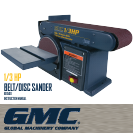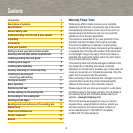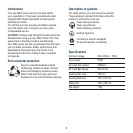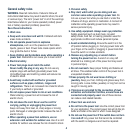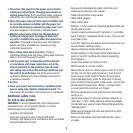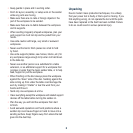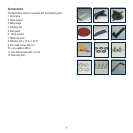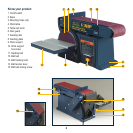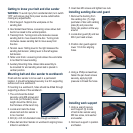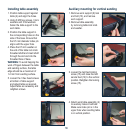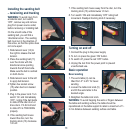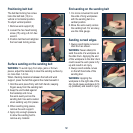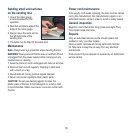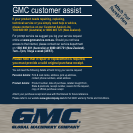5
c. Disconnect the plug from the power source before
making any adjustments, changing accessories, or
storing power tools.
Such preventive safety measures
reduce the risk of starting the power tool accidentally.
d. Store idle power tools out of the reach of children and
do not allow persons unfamiliar with the power tool
or these instructions to operate the power tool.
Power
tools are dangerous in the hands of untrained users.
e. Maintain power tools. Check for misalignment or
binding of moving parts, breakage of parts and
any other condition that may affect the power tools
operation. If damaged, have the power tool repaired
before use. Many accidents are caused by poorly
maintained power tools.
f. Keep cutting tools sharp and clean. Properly
maintained cutting tools with sharp cutting edges are less
likely to bind and are easier to control.
g. Use the power tool, accessories and tool bits etc.,
in accordance with these instructions and in the
manner intended for the particular type of power
tool, taking into account the working conditions and
the work to be performed.
Use of the power tool for
operations different from those intended could result in
a hazardous situation.
5. Service
a. Have your power tool serviced by a qualified repair
person using only identical replacement parts.
This
will ensure that the safety of the power tool is maintained.
Additional safety rules
for belt & disc sanders
WARNING: To avoid mistakes that could cause serious
permanent injury, do not plug the sander in until the
following steps are completed:
• Assembly and alignment
• Learn the use and function of the On/Off switch,
backstop, belt tracking knob, belt tension lever, work table
and work table tilt lock knob.
• Review and understand all safety instructions and
operating procedures in this manual.
• Read manual before using sander
• Wear safety goggles
• Wear a dust mask
• Maintain 1-2 mm maximum clearance between table and
sanding belt and disc
• Always support workpiece with “backstop” or “worktable”
• Avoid “kickback” (workpiece thrown at you). Use only left
hand side of disc.
• Avoid fire. Clean out all sawdust and disconnect from any
vacuum before sanding metals.
• Always unplug the sander before moving it.
• Put the sander on a firm level surface where there is
plenty of room for handling and properly supporting
the workpiece.
• Support the sander so it does not rock.
• Bolt the sander to its work surface.
• Never stand on the tool. Serious injury could occur if the
tool tips. Do not store anything above or near the tool
where anyone might stand on the tool to reach them.
• Check damaged parts, check for alignment of moving
parts, binding of moving parts, broken parts, - Do not use
sanding belts narrower than 100mm – narrower belts
uncover parts that could trap your fingers.
• Remove adjusting keys and wrenches from tool before
turning it on.
• Adjust work support to clear the sanding surface by no
more than 1-2 mm. When checking clearance between
the belt and work support, press the belt flat against the
metal beneath it.
• Make sure all clamps and locks are tight and no parts
have excessive play.
• Never use the sander near flammable liquids, vapors
or gases.



